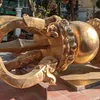Talent, taste, tenacity—Tips for creative success from the artists of the Avyanna exhibition
In our second photo essay on the exhibition by the Oorja art collective, we share more pictorial highlights and creativity tips.
Launched in 2014, PhotoSparks is a weekly feature from YourStory, with photographs that celebrate the spirit of creativity and innovation. In the earlier 750 posts, we featured an art festival, cartoon gallery. world music festival, telecom expo, millets fair, climate change expo, wildlife conference, startup festival, Diwali rangoli, and jazz festival.
The works of eight women artists were featured on the occasion of International Women’s Day as part of the exhibition titled Avyanna (‘strong, powerful, beautiful woman’). It was hosted at the Bangalore International Centre, and organised by art collective Oorja and curator MG Doddamani (see Part I of our coverage here).

Oorja (‘feminine vitality’) brings together artists to support causes and donate to charitable institutions. The featured artists are Bina Mirchandani, Esha John, Evanka Thimmaiah, Kanthi V, Neelam Malhotra, Pushpa, Ritu Chawla Mathur, and Vanaja Bal.
“Avyanna by Oorja is a show that is very close to my heart. As a teacher and mentor of art I have been interacting with women, men and children in all age groups,” Doddamani tells YourStory. See our coverage of his earlier work with the Oorja collective here.
“These studio sessions gave me an insight into how women of different walks of life and ages explore their talent and passion with utmost dedication. Most of these women are multi-taskers who also want to pursue their passion and talent,” he adds.

He chose the week of International Women’s Day to showcase, celebrate and empower these artists. Doddamani has trained and mentored them for more than 12 years.
Each artist explores diverse themes of nature, spirituality, divinity, human form, and daily life, as shown in this photo essay.
Themes and artworks
“One of my paintings, titled Pōnnāl, is a striking portrait of a Kodava woman rendered in coffee as a nod to my Coorg heritage,” explains artist-designer Evanka Thimmaiah. She is also depicted holding a rifle, symbolising the resilience and strength of Kodava women.
Another painting is titled Podiya. “It is created on an heirloom saree passed down by my mother. Through intricate detailing, the painting portrays the process of wearing a Kodava saree, showcasing the evolution of the garment over generations,” Thimmaiah adds.

Evanka Thimmaiah
She is involved in a range of projects in new mediums and community collaborations, delving into Kodava culture for inspiration. “These endeavours reflect my commitment to artistic growth, creativity, and community involvement,” she affirms.
Ritu Chawla is continuing with presenting her collective titled The Doors: Untold Stories. The semi-abstract mixed-media paintings create stories on canvas with doors from all over the world.
“I believe that in ordinary objects like doors and windows, art allows me to go beyond the shallow and literal interpretations that scratch no deeper than the surface. Instead, a door to me symbolises transition and metamorphosis,” she explains.

Ritu Chawla
A door leads from one state of being to the next. “This way, my imagination helps me create and delve into imaginary stories,” she adds.
Her newest collection includes a beautiful old doorway from a Chettinad mansion that caught her fancy during her work travels. “In my next project, I plan to recreate the main door of our ancestral home in Jaipur, with complete 3D imagery,” Chawla says.
The theme of Bina Mirchandani’s works is Explorations in Nature. “As a subject, nature fascinates me with its myriad hues, forms and most importantly, its perfection,” she explains.

Bina Mirchandani anchoring the inauguration
She has drawn inspiration from a friend's lily pond. “I was transfixed by the peace, calm and serenity that I felt standing there. My abstracts were inspired by a trip to the Andamans where I saw patterns in the sand where the water receded, tree trunk patterns, fossils of mushrooms, and a lot more,” she describes.
Her future works explore infinite and divergent patterns such as the Fibonacci series and the sacred geometry of the Vedas. “There are patterns in all of creation. I am very excited about this new project, both from the learning aspect and translating it into artworks,” Mirchandani enthuses.

Esha John
“I have chosen to masterfully employ an orchestral interlude in a monochromatic palette, infusing each piece with a sense of calm and quietude using subjects of nature,” Esha John describes.
“Yet, amidst the subtle hues, a judiciously-placed pop of colour emerges. It breathes life into the canvases, much like the vivid moments that nature gifts us,” she adds.
Her next works feature a tropical garden and a fish and pond series in oil and soft pastels. She also has a few commissioned projects on hand.

Vanaja Bal’s exhibited paintings are part of the series, The Circle of Life. “The circle depicts wholeness which has no beginning and no end,” she explains.
It shows nature’s way of maintaining balance by taking and giving life back to earth. “Hands are portrayed as a source of energy in ever-changing roles at different stages in life,” she adds.
Tips and advice
The artists also share tips for aspiring artists on talent, tastes and focus, and the importance of community and mentorship.
“An eye-opener for me in my journey was that I don’t need to be good at everything, in all mediums and all subjects! Just because you used to love painting detailed sceneries and flowers in water colour doesn’t mean you will love it now or later,” Chawla observes.

It is okay if tastes change. “Once you have spent some time experimenting with your art, it’s time to narrow your focus and find your art style,” she advises.
Creativity and artistic abilities are God-gifted talents, according to John. “Never give up any talent for other careers,” she advises.
“Age is no bar for you to be beginning or continuing your passion. Always be persistent and believe in yourself more than anything,” she adds.

“I feel artists need to work fearlessly and with gay abandon. One should not be scared to make mistakes, for a blunder could end up as a masterpiece,” Bal advises.
“Stay true to your vision and artistic voice, practice regularly, explore various techniques, and seek inspiration from diverse sources,” Thimmaiah advises.
“Learn from fellow artists, and embrace failure as a chance to learn and grow. Network and collaborate with others in the artistic community, stay open-minded, and welcome constructive feedback,” she says.

Persistence and resilience are also important. “Believe in yourself and the significance of your artistic expression,” she urges.
“If art is your passion, make time for it. You will not only excel at it, but you will always be in a happy space,” Mirchandani affirms.
Finding a really good teacher helps in the early stages. “There is a lot to learn in this field, lots of mediums you can use, and a lot of techniques,” she says.

She expresses her gratitude to her teacher and mentor MG Doddamani in this regard. "He urged me on to do this exhibition as I wasn't sure my art was ready for public viewing," she recalls.
“You need to understand what you resonate with. That will help produce your best art,” Mirchandani signs off.
Now what have you done today to pause in your busy schedule and harness your creative side for a better world?









(All photographs were taken by Madanmohan Rao on location at the exhibition.)
Edited by Kanishk Singh













